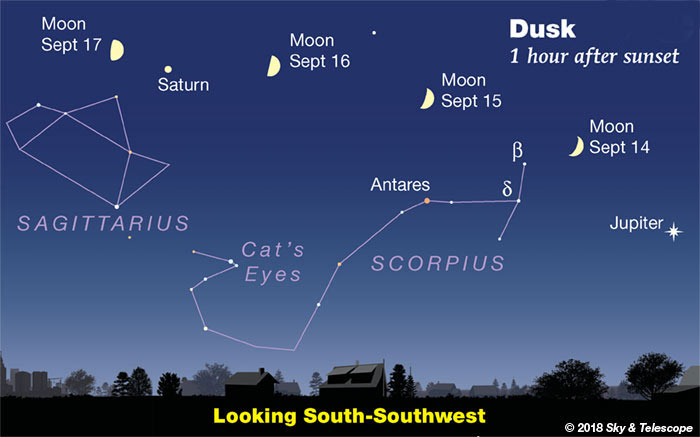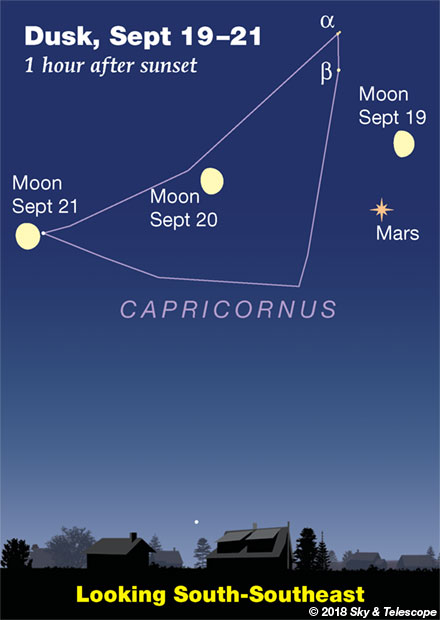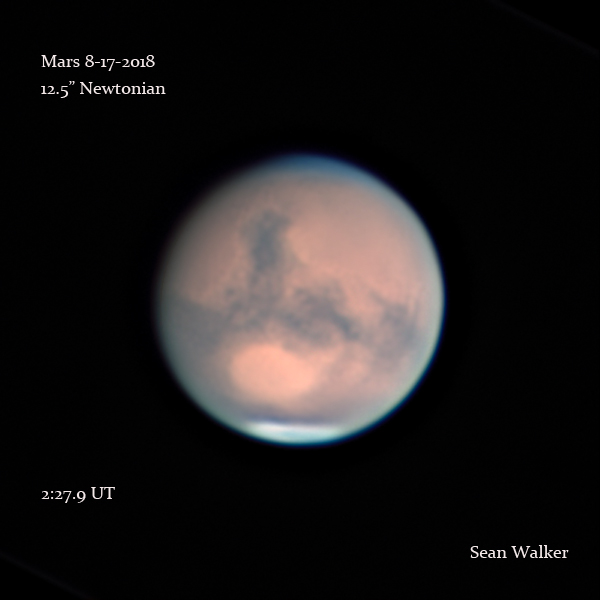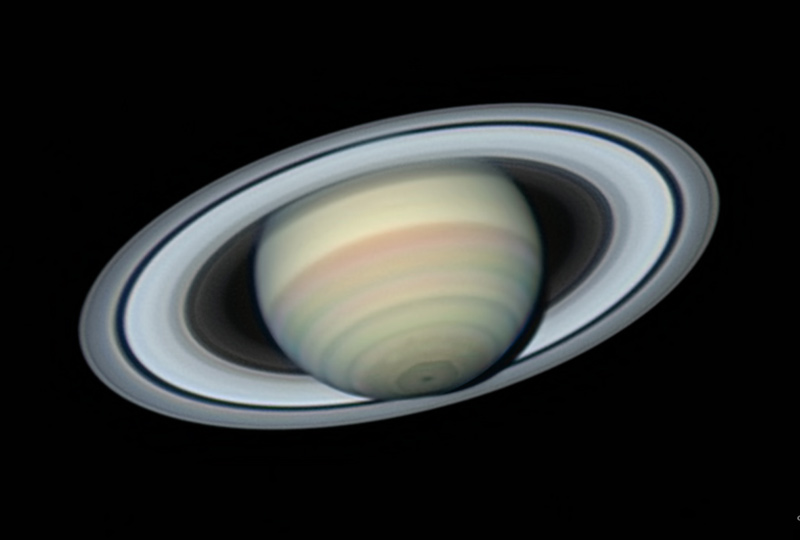
Friday, September 14
• It's the last week of summer! In twilight this evening, catch the crescent Moon in the southwest with Jupiter to its lower right, as shown here. A line from the Moon through Jupiter points toward Venus, much lower.
• Once nightfall is complete, the two brightest stars (not planets) are Vega high overhead and Arcturus in the west. Both are magnitude 0.
Draw a line down from Vega to Arcturus. A third of the way down you cross the dim Keystone of Hercules. Two thirds of the way you cross the dim semicircle of Corona Borealis with its one modestly bright star: Alphecca, the gem of the crown.
Saturday, September 15
• The Moon hangs over Antares at nightfall, as shown above. Far to the Moon's left are Saturn, then Mars. To the Moon's lower right is Jupiter.
And look far to Jupiter's lower right to catch Venus before it sets.
• Early on Sunday morning the 16th, a 7.2-magnitude star in Taurus will be occulted for up to 5 seconds by the faint (12th-magnitude) asteroid 80 Sappho, along a shadow track running from central California to Maine. Details, map, finder charts.
Sunday, September 16
• First-quarter Moon (exact at 7:15 p.m. EDT). The Moon, half lit, shines to the right of Saturn by less than a fist at arm's length, as shown above. Can you still catch low Antares around the end of twilight, about a fist and a half to the Moon's lower right?
Monday, September 17
• Now the Moon shines closer to Saturn's upper left at dusk, as shown above. Mars is two or three fists to their left.
Tuesday, September 18
• Now, at dusk, the Moon forms the top of a triangular bridge with Mars to its left and Saturn to its right.

Wednesday, September 19
• The Moon and Mars travel across the southern sky together this evening. Mars is currently 200 times farther away than the Moon. Find Saturn almost three fists to their right or lower right. Saturn is almost 20 times farther now than Mars.
Thursday, September 20
• The yellow-orange point to the right of the Moon this evening is Mars. Once night is fully dark, look for Fomalhaut, the Autumn Star, rising about three fists to the Moon's lower left (out of the frame here).
Friday, September 21
• The closing days of summer (the equinox is tomorrow) always find the Sagittarius Teapot moving west of south during evening and tipping increasingly far over to the right, as if pouring out the last of summer.
Saturday, September 22
• The September equinox occurs at 9:54 p.m. Eastern Daylight Time, when the Sun crosses the equator heading south for the season. This moment marks the beginning of autumn in the Northern Hemisphere. And the Sun sets almost exactly due west.
• Coincidentally, when summer turns to autumn Deneb takes over from brighter Vega as the zenith star after nightfall (for skywatchers at mid-northern latitudes).
• After dark tonight, the Great Square of Pegasus balances on one corner about three fists at arm's length to the left or upper left of the gibbous Moon. The Square's upper right side points down more or less toward the Moon.
________________________
Want to become a better astronomer? Learn your way around the constellations! They're the key to locating everything fainter and deeper to hunt with binoculars or a telescope.
This is an outdoor nature hobby. For an easy-to-use constellation guide covering the whole evening sky, use the big monthly map in the center of each issue of Sky & Telescope, the essential guide to astronomy.

Once you get a telescope, to put it to good use you'll need a detailed, large-scale sky atlas (set of charts). The basic standard is the Pocket Sky Atlas (in either the original or Jumbo Edition), which shows stars to magnitude 7.6.
Next up is the larger and deeper Sky Atlas 2000.0, plotting stars to magnitude 8.5; nearly three times as many. The next up, once you know your way around, are the even larger Interstellarum atlas (stars to magnitude 9.5) and Uranometria 2000.0 (stars to magnitude 9.75). And read how to use sky charts with a telescope.
You'll also want a good deep-sky guidebook, such as Sue French's Deep-Sky Wonders collection (which includes its own charts), Sky Atlas 2000.0 Companion by Strong and Sinnott, or the bigger Night Sky Observer's Guide by Kepple and Sanner.
Can a computerized telescope replace charts? Not for beginners, I don't think, and not on mounts and tripods that are less than top-quality mechanically (meaning heavy and expensive). And as Terence Dickinson and Alan Dyer say in their Backyard Astronomer's Guide, "A full appreciation of the universe cannot come without developing the skills to find things in the sky and understanding how the sky works. This knowledge comes only by spending time under the stars with star maps in hand."
This Week's Planet Roundup


Mercury is hidden in conjunction with the Sun.
Venus (magnitude –4.7) shines very low in the west-southwest in evening twilight and sets before twilight is over. Don't confuse it with Jupiter, which will probably catch your attention first. Venus is to Jupiter's lower right, and brighter. Their separation diminishes slightly this week, from 16° to 14°.
In a telescope Venus is a striking crescent, about 30% sunlit and 36 arcseconds tall. For better telescopic seeing, catch it higher in a blue sky long before sunset.
Mars, in southern Capricornus, fades from magnitude –1.7 to –1.5 this week, still a trace brighter than Sirius. It shines highest in the south about an hour after dark and sets around 2 a.m.
In a telescope Mars shrinks from 18½ to 17 arcseconds wide this week. The dust in the Martian atmosphere continues to settle, allowing surface markings to show with slightly better contrast. For a Mars map that displays which side is facing Earth at your time and date, use our Mars Profiler.
Jupiter (magnitude –1.9, in Libra) shines ever lower in the southwest in twilight.
Saturn (magnitude +0.4, above the spout-tip of the Sagittarius Teapot) glows yellow in the south at dusk, well to the right of brighter Mars. It sets by midnight.
Uranus, near the Aries-Pisces border, is easy in binoculars at magnitude 5.7 — if you have a finder chart and know the constellations well enough to get started with it.
Neptune, in Aquarius, is harder at magnitude 7.8. By late evening both are well up in the east and southeast, respectively. Finder charts for Uranus and Neptune, or see the September Sky & Telescope, page 48.
______________________
All descriptions that relate to your horizon — including the words up, down, right, and left — are written for the world's mid-northern latitudes. Descriptions that also depend on longitude (mainly Moon positions) are for North America.
Eastern Daylight Time (EDT) is Universal Time (also called UT, UTC, GMT, or Z time) minus 4 hours.
______________________
"Remember to look up at the stars and not down at your feet. Try to make sense of what you see and wonder about what makes the universe exist. Be curious."
— Stephen Hawking, 1942–2018
______________________
"The dangers of not thinking clearly are much greater now than ever before. It's not that there's something new in our way of thinking, it's that credulous and confused thinking can be much more lethal in ways it was never before."
— Carl Sagan, 1996
______________________
"Objective reality exists. Facts are often determinable. Vaccines save lives. Carbon dioxide warms the globe. Bacteria evolve to thwart antibiotics, because evolution. Science and reason are not a liberal conspiracy. They are how we determine facts. Civilization's survival depends on our ability, and willingness, to do this."
— Alan MacRobert, your Sky at a Glance editor
______________________
"Facts are stubborn things."
— John Adams, 1770
 3
3








Comments
misha17
September 14, 2018 at 3:39 pm
For the next couple of weeks, if there is a halo around the sun near sunrise or sunset, look for 2 bright spots on the halo to the north or south of the sun. Those are "sun dogs". Since the halo is 22 degrees in diameter, the "sun dogs" roughly mark the sunrise/sunset points for at the Summer (northern "dog") and Winter (southern "dog") solstices.
You must be logged in to post a comment.
Rod
September 15, 2018 at 11:35 am
"Wednesday, September 19• The Moon and Mars travel across the southern sky together this evening. Mars is currently 200 times farther away than the Moon. Find Saturn almost three fists to their right or lower right. Saturn is almost 20 times farther now than Mars."
Okay, the Moon is about 30 arcminute size this month in the telescope view and Mars and Saturn are both near 17 arcsecond size now. How can we show Mars is closer to Earth than Saturn vs. Mars and Saturn are both the same size and similar distance from Earth because they both share a similar arcsecond size now?
You must be logged in to post a comment.
Rod
September 18, 2018 at 10:49 pm
I observed Mars, Saturn, and the waxing gibbous Moon tonight from about 2030-2130 EDT. Mars stopped retrograding just across border into Sagittarius on 28-Aug and tonight was in Capricornus near the star HIP100148 (mv +7.75) in the same field using 40x and 1.3 degree true field. Mars moved nearly 5 degrees eastward along the ecliptic since it stopped retrograding 28-Aug. I viewed Mars and Saturn at 40x and 1.3 degree true field of view. Saturn stopped retrograding 06-Sep-18. Both planets are near 17 arcsecond size now.
You must be logged in to post a comment.
You must be logged in to post a comment.